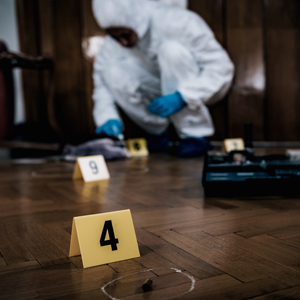Forensic Evidence You Can Collect Without Police | Private Evidence Tips

- Info and Tips
Forensic Evidence You Can Collect Without Police
Sometimes, you notice something’s not right—maybe items are moved, or something feels off in your space.
You want answers, but calling the police right away might not feel necessary or helpful. The truth is, there are some things you can look for and collect on your own.
This doesn’t mean taking over a full investigation, but knowing what signs to look for can give you a better sense of what’s going on.

Image Source: Canadian Police Knowledge Network
Understanding Trace Evidence
Trace evidence refers to the small, sometimes invisible materials that are left behind during contact between people, objects, or places.
These bits of evidence are often things like strands of hair, fibers from clothing or carpets, tiny glass pieces, flakes of paint, or even soil. Though small, trace evidence can help connect a person to a location or event when handled correctly.
You don’t need to be a professional to spot or collect trace evidence, especially if you’re trying to understand what happened in a private space, like your home or car. However, it’s important to avoid touching the evidence directly.
Using gloves, clean tweezers, and sealable bags or containers can help reduce the risk of contamination. Always store each item separately and label it with the date, time, and location you found it.
Trace evidence can tell part of a story, especially when something feels off, like after a break-in, a strange encounter, or a missing item.
If handled carefully, it may later help experts if you decide to bring in law enforcement or a private investigator. Just remember, preserving it properly is key.
Collecting DNA Samples for Private Use
In some situations, you may want to collect DNA without involving the police, especially if it’s for personal reasons like resolving doubts, understanding a situation better, or preparing for private testing.
DNA can be found in items like used tissues, hair with the root attached, toothbrushes, or even a drinking glass. These items can hold enough genetic material for testing.
If you do decide to collect DNA, it’s important to handle everything carefully. Use clean gloves, and avoid touching the sample directly.
Place the item in a clean paper envelope or breathable container instead of plastic, which can trap moisture and damage the sample. Label it with the date, time, and location, and store it in a cool, dry place.
While private DNA testing services are available, it’s important to understand their limits. Results may help give you peace of mind or clarity, but they may not always hold up in legal settings without proper documentation and consent.
If you’re collecting DNA from someone else, make sure you’re not violating any privacy laws. When in doubt, talk to a legal professional first.
Fingerprints and What You Can Collect
Fingerprints are one of the most common types of physical evidence and can tell a lot about who touched what. While police usually handle this kind of evidence, there are cases where you might want to lift fingerprints yourself, especially after a break-in, dispute, or when something doesn’t feel right at home.
If you suspect someone has been in your space, checking smooth surfaces like doorknobs, glass, or metal objects may reveal prints.
You don’t need fancy tools to start. A soft brush (like a makeup brush), fine powder (even cocoa powder in a pinch), and clear tape can help you lift prints carefully.
Once you’ve dusted the area and gently applied the tape, place it on a clean white card or paper and label it with the time, date, and where it came from.
Keep in mind, homemade fingerprint lifting is mostly useful for personal awareness or for showing a private investigator. It likely won’t hold up in court, especially if it’s not collected with official procedures.
Still, it can be a useful way to gather details and possibly confirm suspicions before choosing your next steps.
Handling Firearms Evidence Cautiously
Coming across bullets, casings, or anything related to a firearm can be alarming, especially if it’s unexpected or not part of a controlled setting like a shooting range.
In rare situations—such as after a disturbance in a private space—you might feel the need to collect this type of evidence yourself before it’s moved or cleaned up. However, firearms evidence is highly sensitive and comes with serious legal and safety concerns.
If you do choose to collect it, never touch the surface with your bare hands. Always use gloves to avoid adding your fingerprints or damaging any that might already be there.
Place shell casings or bullets in separate containers—preferably paper, not plastic—to allow air flow and prevent moisture buildup. Write down the date, time, and exact spot you found each item.
Legal and Practical Limits of Collecting Evidence Yourself
While collecting your evidence might seem like the right move—especially when you feel something is off—it’s important to know there are limits. Not everything you gather will hold up in court, and if it’s not collected or handled the right way, it could be dismissed entirely.
Police and legal teams follow strict rules to make sure evidence is valid, uncontaminated, and properly documented. Most people collecting things on their own don’t have access to those tools or training.
There’s also the legal side to think about. For example, if you’re trying to collect evidence from someone else’s property or belongings without permission, you might be crossing a legal line, even if you’re trying to protect yourself. What you find could still be considered illegally obtained, which may not help your case at all.
When to Stop and Call the Authorities
There’s a point where trying to collect evidence on your own is no longer safe or smart. If you come across something that suggests a serious crime—like signs of forced entry, a weapon, or anything that makes you feel unsafe—it’s time to step back.
Trying to handle or investigate something beyond your knowledge can not only put you in danger, but also harm any real investigation that may follow.
You should also call the police if you believe someone is actively in your space without permission, or if there are repeated signs that someone’s been entering your home or property.
Law enforcement has the training and tools to collect evidence the right way, and more importantly, they can step in to keep you protected.
Conclusion
Collecting your forensic evidence can be helpful in very specific situations, especially when you’re dealing with private matters or just want answers. But it comes with risks.
The truth is, not everything should be handled without professional help. Mistakes in how you collect or store items can ruin their value, both for personal use and in any future legal setting.
Use common sense. If something seems suspicious or feels unsafe, don’t try to solve it all on your own. Trust your instincts, gather only what you can safely, and bring in professionals when needed. Knowing where your role ends is just as important as knowing how to begin.
FAQs
What are four common ways to collect trace evidence?
Trace evidence is usually small and easy to miss. It can be collected using tweezers, tape, swabs, or special vacuums, depending on the surface and type of material, like hair, fibers, or dust.
What are the five types of evidence usually collected at a crime scene, and why?
Common types include blood or hair for DNA, fingerprints to ID people, shoe or tire prints to track movement, fibers or soil for trace links, and items like glass or paint to connect scenes or suspects.
How is forensic evidence collected properly?
First, the evidence is photographed and documented. Then it’s placed in a paper bag or envelope, sealed, and signed with the date and time to keep it secure and valid for use.
What are five examples of trace evidence?
Examples include hair, fibers, paint chips, glass pieces, and gunshot residue. These small items can link people or objects to a crime scene.